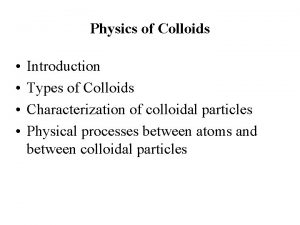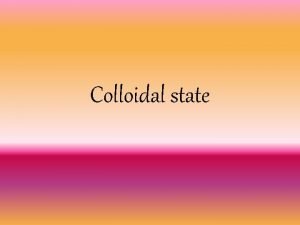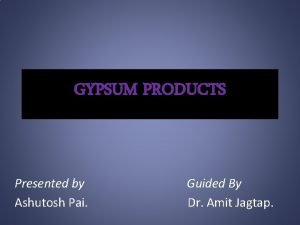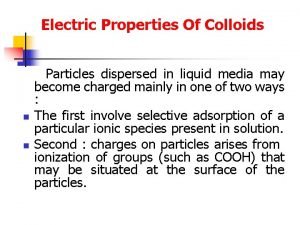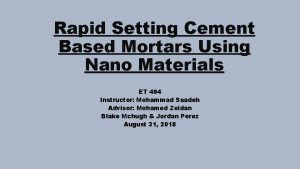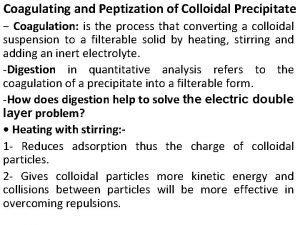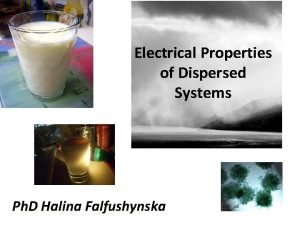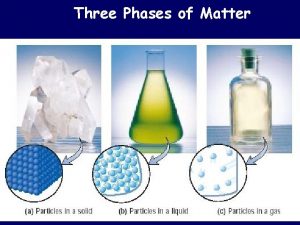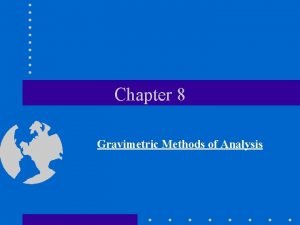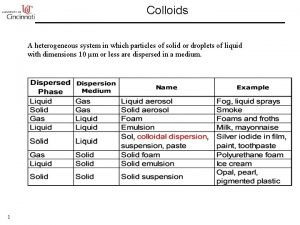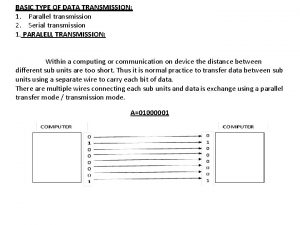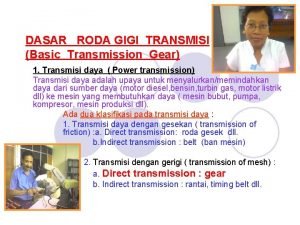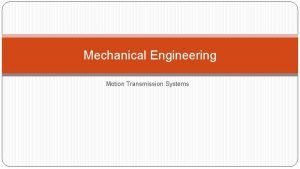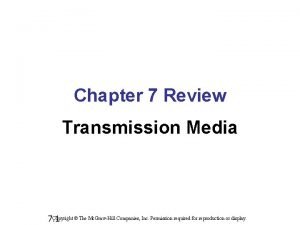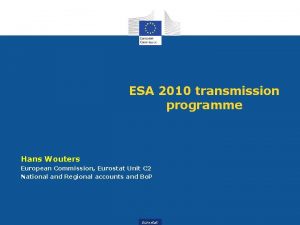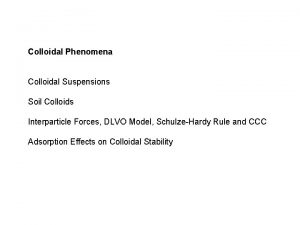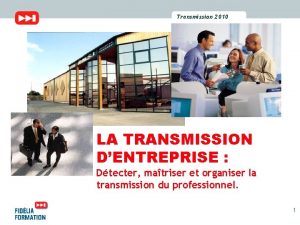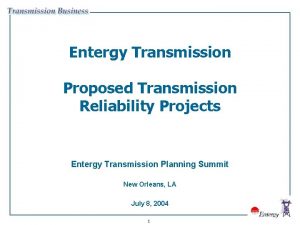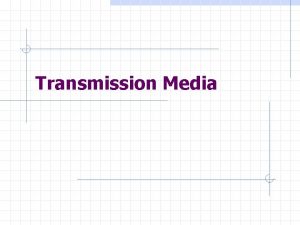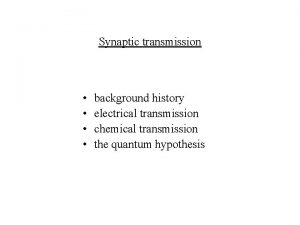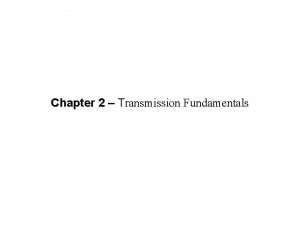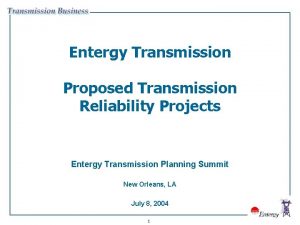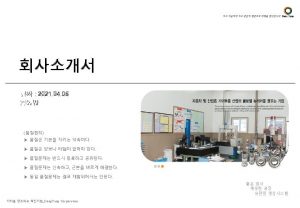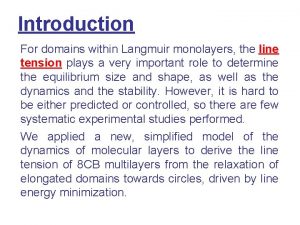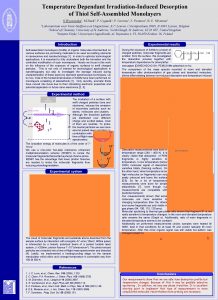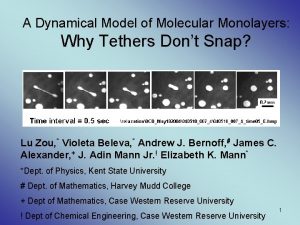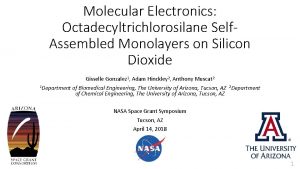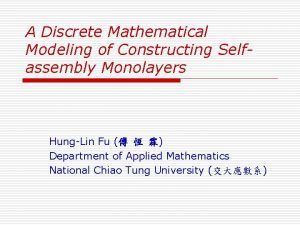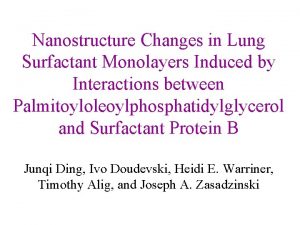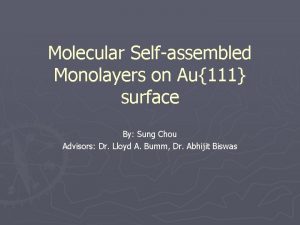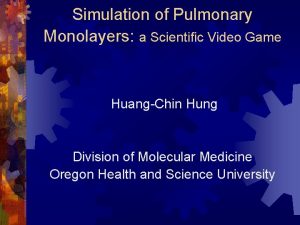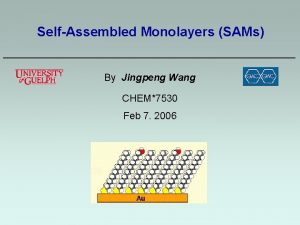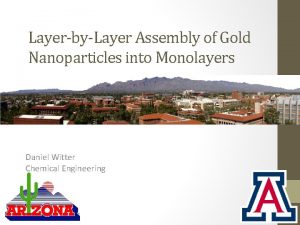TRANSMISSION THROUGH COLLOIDAL MONOLAYERS WITH AN OVERLAYER A



























- Slides: 27

TRANSMISSION THROUGH COLLOIDAL MONOLAYERS WITH AN OVERLAYER – A THEORETICAL CONSIDERATION N. Arnold Angewandte Physik, Johannes - Kepler - Universität A-4040, Linz, Austria N. Arnold, Applied Physics, Linz

Summary • History and motivation • Transmission of bare colloidal monolayers • Rayleigh-Wood anomalies in diffraction • a-Si covered monolayers • Photonic crystals • Mode profiles and coupling • Metal covered monolayers • Minimal model of plasmon-mediated transmission N. Arnold, Applied Physics, Linz

History and motivation • Patterning in Laser Cleaning and with ML arrays (Konstanz, Singapore) • Arrays of microspheres on support used for processing (Linz) need to understand the bare ML transmission properties • a-Si covered spheres for light manipulation need to understand the transmission properties with the Si overlayer • Metal coated spheres for LIFT and apertured spheres arrays need to understand plasmonic effects N. Arnold, Applied Physics, Linz

Transmission measurements • Spectrometer • Far field, direct transmission (normal or oblique) • Not a laser light • Non-polarized • Monolayer domains in irradiated area N. Arnold, Applied Physics, Linz

Bare Si. O 2 monolayer • Decrease at small : • Diffraction grating, interference from a “primitive cell”: • Dip: wavelength scales with d: d/ ~1. 12 • No order - no dip N. Arnold, Applied Physics, Linz

Rayleigh-Wood anomaly Known in gratings of all types. Diffracted waves at the grazing angle couple consume energy Energy conservation dip in zero order (normal transmission) Large-angles requires full 3 D vector Maxwell equations. k k b k’=k +b k N. Arnold, Applied Physics, Linz

Dip condition Bragg condition: Normal incidence, 1 st order diffraction, possibility to couple b - reciprocal lattice (2 D hexagonal) b 2 b 1 M K a 2 Effective nmon from the filling factor f ≈ 0. 6 a 1 and mixing law for : N. Arnold, Applied Physics, Linz

FDTD calculations λ/d=0. 8 λ/d=1. 0 N. Arnold, Applied Physics, Linz

FDTD calculations λ/d=1. 1 dip λ/d=1. 2 N. Arnold, Applied Physics, Linz

a-Si covered monolayers • Transmission spectrum: • Main dip deepens and red shifts with increasing thickness • Multiple dips appear L. Landström, D. Brodoceanu, N. Arnold, K. Piglmayer and D. Bäuerle, Appl. Phys. A. 81, 911 (2005). N. Arnold, Applied Physics, Linz

Relation to photonic crystals • ML with the overlayer = photonic crystal slab (PCS) with high contrast (like inverted opal) (3<n. Si<5) • Dip = diffracted wave couples to the mode • Multiple modes multiple dips • Normal incidence: θ=0 dips corresponds to the ω d/ λ of the lowest modes at the center (Γ-point) of the Brillouin zone in the (multivalued) frequency surface ω(k) • Confined modes – periodic in-plane, evanescent in z-direction – no good software use supercells, filter out folded modes b 2 b 1 M K a 2 a 1 N. Arnold, Applied Physics, Linz

Computational scheme Supercell 5 d in z-direction Modes at Γ-point # 22 folded # 20 true • Smoothened ε profile True vs. folded modes: • Plane wave expansion • Structure • Deposit – shifted spheres • Si-confinement h-dependence • h/d=0. 2, support included • Supercell dependence, number N. Arnold, Applied Physics, Linz

Dependence on the overlayer thickness Estimation with neff Squares – experimental dip positions L. Landström, N. Arnold, D. Brodoceanu, K. Piglmayer and D. Bäuerle, Appl. Phys. A. 83, 271 (2006). N. Arnold, Applied Physics, Linz

Mode profiles Modes are mainly in Si deposit (larger n) h/d=0. 175 • Lowest “donut” mode • “Main dip” mode • From lowest ML mode at h=0, has azimuthal E structure • 6 -fold symmetry • Good coupling into 6 waves • Weak coupling (FDTD) N. Arnold, Applied Physics, Linz

FDTD coupling λ/d=1. 87 λ/d=1. 54 λ/d=1. 24 donut Measured dip Measured maximum h/d=0. 175, n. Si. O 2=1. 35, spheres, nglass=1. 42, n. Si=3. 3 Ez ↕ (incident) component shown Dip is broad in λ, several coupling modes N. Arnold, Applied Physics, Linz

Effective refractive index Main dip position: neff↑ ω~d/λdip↓ n(λ) neglected here Estimation with neff N. Arnold, Applied Physics, Linz

Oblique incidence • Main dip splits in two • Different directions describe frequency surface dispersion ω(k) near the Γ-point Non-idealities: • ML domains ~100 μm, nonpolarized light orientation averaging point • Various sizes, defects, 3<n. Si<5 • Coupling coefficients • Simplified neff description N. Arnold, Applied Physics, Linz

Orientation-dependent coupling • Main dip mode. Use neff near Γ-point (normal incidence) • Different directions (φkb angle) describe frequency surface dispersion ω(k) φ • Observed transmission is averaged over different orientations φ and polarizations N. Arnold, Applied Physics, Linz

FDTD coupling and polarization θ=π/6, h/d=0. 11 φ=π/2, strong φ=π/2, weaker λ/d=1. 23, Ex ↔ shown φ=π, strong φ=5π/6, weaker λ/d=1. 6, Ez ↕ shown Better coupling to ks E -Dipole effect Note change in mode period N. Arnold, Applied Physics, Linz

Metal-covered monolayers Transmission spectrum: • Metal independent • Bare monolayer minima become maxima • Slightly red shifted • Positions thickness independent • high T values (compare dash and dash-dot) max scales with d 1 st maximum: d/ ~1. 18 L. Landström, D. Brodoceanu, K. Piglmayer, G. Langer and D. Bäuerle, Appl. Phys. A. 81, 15 (2005). N. Arnold, Applied Physics, Linz

Minimal model • Question: Why metal transmits? • Metals: Re <0, FDTD requires 200 points/ • Time consuming minimal model – Metallic Fabry-Perot t 23 3, air 2, metal t 12 1, monolayer nmon r 23 r 21 Standard FP, but: 2 1 Ei Er 3 Et • Evanescent waves • In and out coupling by diffraction: t 01 means from 0 to 1 st order, etc. Ec h L. Martín-Moreno, F. J. García-Vidal, H. J. Lezec, P. M. Pellerin, T. Thio, J. B. Pendry, T. W. Ebbesen, Phys. Rev. Lett. 86, 1114 (2001). N. Arnold, Applied Physics, Linz

Resonant FP denominator evanescent • Transmission large when denominator small • Can happen despite exponential term • For evanescent waves Fresnel coefficient r>>1 is possible p-polarization metalair metalmonolayer 2= metal=-143. 75+12 i (~Ag) 3= air=1 and 1= mon=1. 81 N. Arnold, Applied Physics, Linz

Qualitative transmission (denominator)-1 Ag, h=30 nm p-polarization Main maximummetal-monolayer s-polarization For quantitative description: • Many modes together • Coupling coefficients t difficult • Better FDTD N. Arnold, Applied Physics, Linz

Plasmons and minima to maxima inversion Resonant r>>1 condition < > surface plasmon on the interface 1 st order diffraction, normal incidence, metal-monolayer interface • Almost = bare ML dip condition • Upper part of the ML contains no air • filling f=0. 8>0. 6 nmon↑ λdip↑ • minima become maxima that are red shifted (λ/d=1. 18 vs. 1. 12) (holds for Si. O 2 and PS spheres) N. Arnold, Applied Physics, Linz

Multiple maxima positions Oblique incidence, higher order diffraction: Normal incidence, Ag • Maxima are broad, overlap metal-monolayer • Orientation averaging • All ε depend on λ metal-monolayer and metal-air • Coupling coeffs. t differ • Difficult to say if metal-air interface plays a role N. Arnold, Applied Physics, Linz

Interesting experimental question • Does one need the holes in the metal to see extraordinary transmission? • Or film modulation alone is enough? • The (qualitative) theoretical answer: – it shall work without holes • Difficult to verify (smaller efficiency, cracks) N. Arnold, Applied Physics, Linz

Acknowledgements Prof. D. Bäuerle Dr. L. Landström Dr. K. Piglmayer CD Laboratory for Surface Optics Univ. Doz. Dr. K. Hingerl MSc. J. Zarbakhsh Funding: Austrian Science Fund (FWF), P 16133 -N 08 N. Arnold, Applied Physics, Linz
 Show the different types of colloids with examples
Show the different types of colloids with examples Introduction to analytical chemistry ppt
Introduction to analytical chemistry ppt Colloids and interfaces
Colloids and interfaces Difference between colloidal and crystalline precipitate
Difference between colloidal and crystalline precipitate Colloid state
Colloid state Difference between alpha and beta hemihydrate
Difference between alpha and beta hemihydrate Colloid example food
Colloid example food Protective colloids
Protective colloids Colloidal silica gun mix
Colloidal silica gun mix Peptization
Peptization What is a sol
What is a sol Types of colloidal system
Types of colloidal system Stan jones colloidal silver
Stan jones colloidal silver Difference between colloidal and crystalline precipitate
Difference between colloidal and crystalline precipitate Colloidal system is heterogeneous
Colloidal system is heterogeneous Tangential sawing of timber
Tangential sawing of timber Night of scorpion summary
Night of scorpion summary Sin entered through one man
Sin entered through one man Class 2 furcation
Class 2 furcation Parallel transmission mode
Parallel transmission mode Tuberculose transmission
Tuberculose transmission Basic transmission
Basic transmission Motion transmission systems
Motion transmission systems Caiso transmission planning
Caiso transmission planning Maintaining transmission based isolation precautions
Maintaining transmission based isolation precautions Name the two major categories of transmission media
Name the two major categories of transmission media Esa transmission programme
Esa transmission programme Trypanosoma mode of transmission
Trypanosoma mode of transmission
